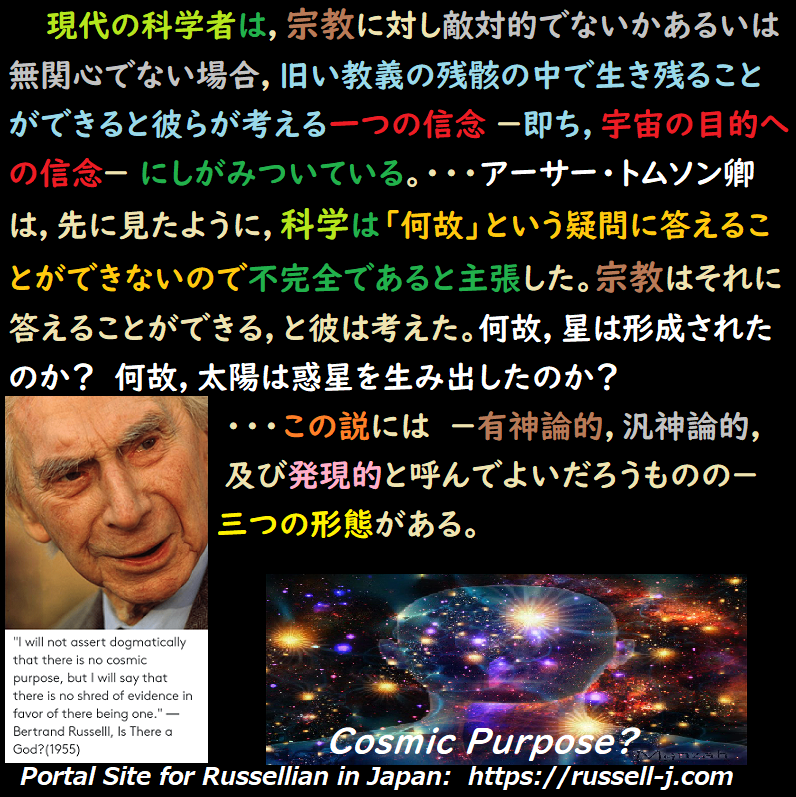現代の科学者は,宗教に対し敵対的でないかあるいは無関心でない場合,旧い教義の残骸の中で生き残ることができると彼らが考える一つの信念(belief 信条) -即ち,宇宙の目的への信念((宇宙には何らかの目的が存在しているとの信念)- にしがみついている(cling to 固執している)。(キリスト教の)リベラルな神学者たちも,同様に,宇宙の目的を彼らの信条(creed)の中心的な条項(article)としている。この説にはいくつかの形態があるが,それらは全て倫理的に価値のあるもの -それはある意味で長い進化の過程全体に対する理由を与えるもの- に向かうという方向性があるという進化の概念 を共通に持っている。アーサー・トムソン卿は,先に見たように,科学は「何故(どうして)」という疑問に答えることができないので不完全であると主張した(訳注:もちろん科学は「なぜ」という疑問のもとに研究をすすめるが,「how どのようにして」という回答はしても、「なぜ(目的)」に答えてくれない。(たとえば)「なぜ宇宙(この世の中)は存在するのか」とか「神は存在するか存在しないか、もし存在する場合はなぜ神はこの宇宙を創ったのか?」という問いには科学は答えてはくれない。哲学者だって答えてくれないが・・・)。 宗教はそれに答えることができる,と彼は考えた。何故,星(恒星)は形成されたのか? 何故,太陽は惑星を生み出したのか? 何故,地球は冷たくなり,ついには生命を生み出しているのか? なぜなら最終的に何か望ましいものを生みだそうとしつつあったからであり - 私はその望ましいものが何かは確信をもてないが,その望ましいものとは(トムソン卿にとっては)科学的神学者や宗教心を持った科学者たちだったと信じる。(注:宗教家たちに対する皮肉か?)(注:荒地出版社刊の津田訳では「それらは,究極的に望ましいものを生み出すためだ。-そう答えた者が何者であるか私にははっきりわからないが,科学的神学たちと宗教心をもった科学者たちだったと思う」と訳出している。構文や文法を無視していないか? それに,ラッセルはリベラルな神学者(自由主義神学者)は宇宙の目的は倫理的に価値を持つものを生み出すと考えているとすぐ前の方で述べているのであるから「そう答えた者が何者であるか私にははっきりわからないが・・・」という訳はでてこないはずであろう。)
この説には -有神論的,汎神論的,及び「発現的(emergent)」と呼んでよいだろうものの- 三つの形態がある。
第1の形態は,最も単純かつ最も正統的なものであり,神はいずれある種の善が展開することを予見したので宇宙を創造し,自然の法則を定めたのだと考える(holds that ~と考える)。この見解においては,目的は創造主の心の中に意識的に存在しており,そうして神は神の創造物(His creation)の外側に残っている。
汎神論的形態においては,神は宇宙の外側に存在するのではなく,神とは一つの全体として考えられた宇宙にすぎない。従って,創造行為はありえず,宇宙の中に一種の創造的力が存在し,その力が宇宙をこの創造力が発展の全過程を通して心に持っている計画に従って宇宙を発展させる(cause A to develop :Aを発展させる)。
「発現的」形態においては,目的はより盲目的である。初期の段階においては宇宙にあるものは後の段階をまったく予見しないが,しかし,一種の盲的目な衝動がより発展した形態を生じさせる変化へと導く。従って,ある程度曖昧な意味で,目的はその始まりにおいて内包されている。
Chapter 8:Cosmic Purpose , n.1
Modern men of science, if they are not hostile or indifferent to religion, cling to one belief which, they think, can survive amid the wreck of former dogmas – the belief, namely, in Cosmic Purpose. Liberal theologians, equally, make this the central article of their creed. The doctrine has several forms, but all have in common the conception of Evolution as having a direction towards something ethically valuable, which, in some sense, gives the reason for the whole long process. Sir J. Arthur Thomson, as we saw, maintained that science is incomplete because it cannot answer the question why? Religion, he thought, can answer it. Why were stars formed? Why did the sun give birth to planets? Why did the earth cool, and at last give rise to life? Because, in the end, something admirable was going to result – I am not quite sure what, but I believe it was scientific theologians and religiously-minded scientists.
The doctrine has three forms – theistic, pantheistic, and what may be called “emergent.” The first, which is the simplest and most orthodox, holds that God created the world and decreed the laws of nature because He foresaw that in time some good would be evolved. In this view the purpose exists consciously in the mind of the Creator, who remains external to His creation.
In the pantheistic form, God is not external to the universe, but is merely the universe considered as a whole. There cannot therefore be an act of creation, but there is a kind of creative force in the universe, which causes it to develop according to a plan which this creative force may be said to have had in mind throughout the process.
In the“emergent”form, the purpose is more blind. At an earlier stage, nothing in the universe foresees a later stage, but a kind of blind impulsion leads to those changes which bring more developed forms into existence, so that, in some rather obscure sense, the end is implicit in the beginning.
出典:Religion and Science, 1935, chapt. 8: Cosmic Purpose
情報源:https://russell-j.com/beginner/RS1935_08-010.HTM

